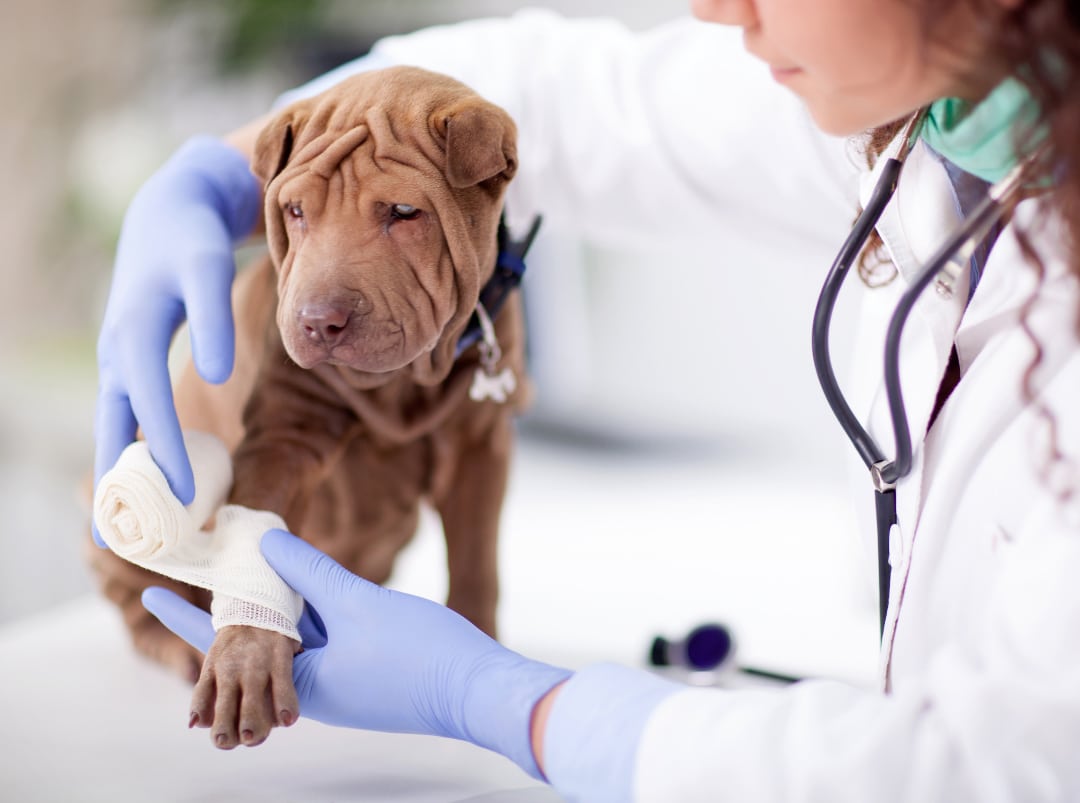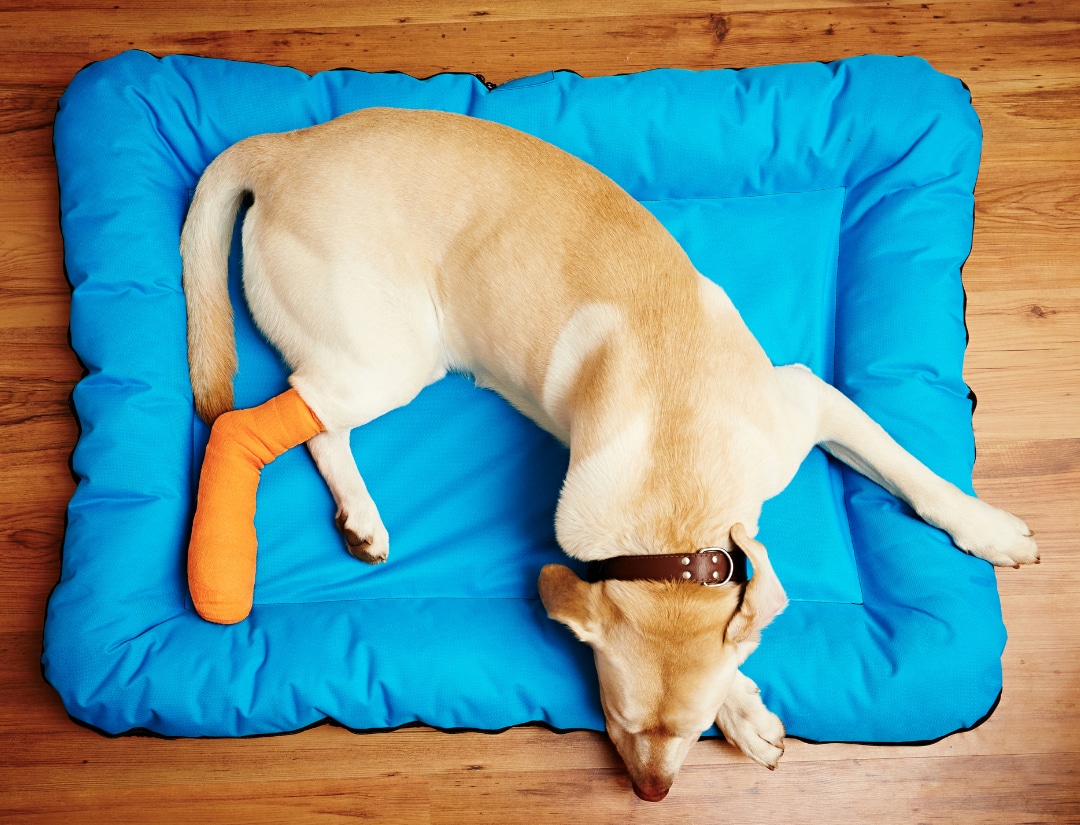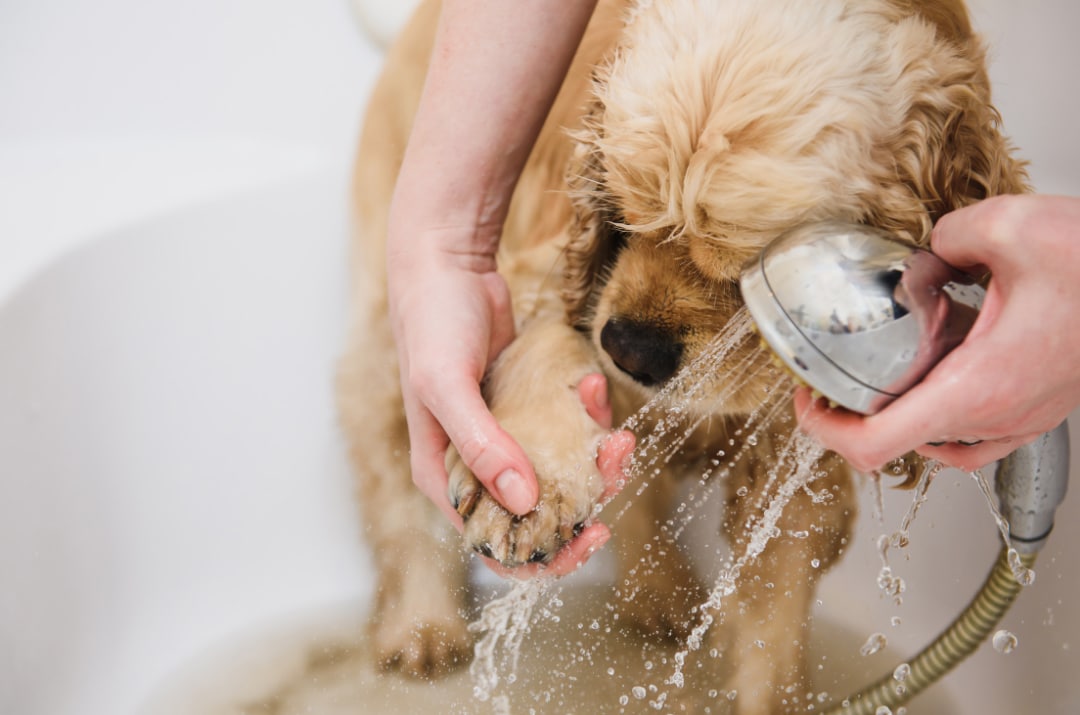Have you ever been in a situation where your pet has been involved in an accident, whether at home or on a walk, and you weren’t sure what to do? While we hope it is never the case, there may be times where we need to provide first aid to our pets. But in order to do so, it’s important to know how to effectively administer first aid treatment before you arrive at the vet. To help, we’ve put together a list of common pet emergencies and how to respond to them if you are ever faced with one.
First aid treatment at home
Most emergencies will require veterinary attention, but in some cases, you will need to know how to stabilise your pet before you arrive at your vet. It is important to note any first aid treatment you administer to your pet at home should always be followed immediately by veterinary care. First aid is by no means a substitute for veterinary care, but it may just save your pet’s life until veterinary treatment can be given.
We recommend preparing a pet first aid kit with basic essentials and keeping it in a safe, easily accessible place in the home. Another kept in the car is also useful for when you are out and about. Caravans and boats are also places where a pet first aid kit can come in handy if your pet is regularly travelling in them.
Pet first aid courses are a great way to further your knowledge and practice your skills so as you are prepared for a real-life situation. There are many pet first aid courses available, including the Australia Red Cross veterinary approved online course.
And remember, if you are ever unsure what to do in a pet emergency, call your vet and they will be able to provide advice and direction over the phone.
Common pet emergencies and what you can do at home to help
There are many types of accidents our pets can get into. But the most common pet emergencies we see in our hospitals, and will discuss how to assist your furry friend until you can get to a vet, are:
- Bleeding, cuts and wounds
- Breathing difficulties
- Eating something poisonous
- Broken bones and fractures
- Hit by a car
- Seizures
- Burns
- Heat Stroke
Bleeding, cuts and wounds
Wounds can be incisions, punctures or abrasions all of which can lead to bleeding. But, luckily, first aid treatment is very similar to how you would stop bleeding for a human. If your pet is bleeding follow these steps:
If your pet allows it, using saline or water, gently wash the area to remove any debris.
- Use a sterile wound dressing or cotton pad and apply direct pressure to the wound to restrict blood flow for at least three minutes (until the blood starts to clot).
- Secure the dressing or pad with a bandage (or a clean t-shirt or sock if you have none). Take care the bandage isn’t too tight.
- If possible elevate the injured limb to slow blood flow and to further encourage clotting.
- If bleeding continues, leave the first dressing or pad in place and put a second pad over the top and secure with another bandage.
- Transport your pet to the vet.
Breathing difficulties
Breathing difficulties can be caused by a number of things such as heart failure, asthma, allergic reactions, foreign objects becoming stuck in their airways, poisonings, aspiration pneumonia, paralysis of the chest wall, and brachycephalic airway obstructive syndrome just to name a few. Regardless of the underlying cause of your pet’s breathing difficulties, it is always a life-threatening condition that requires immediate veterinary care. Should your pet start to experience difficulties breathing:
- Keep them as quiet and calm as possible.
- Transport them immediately to the vet.
- If your pet suddenly stops breathing start to administer CPR. Follow our instructions on our CPR blog to learn how to perform it on pets.
Eating something poisonous
Our pets are curious creatures who can’t always resist the temptation to eat things they really shouldn’t. If you think your pet has eaten something poisonous:
If possible, try to remove it from their mouths. Don’t try to make your pet vomit at home as this is fraught with danger.
- Try to determine how much your pet has eaten and contact your vet.
- If your vet recommends immediate treatment at their clinic, take the packaging of what your pet has eaten with you as this will help your vet in their treatment.
Broken bones and fractures
There are many different types of accidents that can cause broken bones and fractures in our pets, such as suffering from a fall or being hit by a car. If you suspect your pet has a broken bone or has a fracture follow these steps:
If it is an open fracture where the bone is exposed, attempt to cover the bone with a moist bandage if your pet allows you to.
- Avoid attempting to set the bone or making a splint. Without pain relief touching the area may cause your pet to lash out.
- Try to move the affected area as little as possible to avoid further damage, by placing your pet on a flat surface, and transport them to the vet.
Hit by a car
Unfortunately, car accidents are a very common cause for pets to be taken to an emergency hospital. These accidents are extremely painful and the injuries pets can sustain include broken bones, bleeding, and internal injuries (even if they seem normal after the accident). Directly following the accident:
- Ensuring you don’t put yourself in danger, secure the area by appointing people to redirect cars if needed.
- If your pet is unconscious check for breathing and heartbeat. Should you not be able to detect breathing or have a heartbeat start CPR and continue until you reach veterinary help.
- If your pet is bleeding apply bandages with firm pressure to stem the bleeding.
- Transport your pet to the vet immediately. If your pet is unable to move by themselves, place them on a flat board for support and to avoid causing further injury.
Seizures
Witnessing your pet having a seizure for the first time is very scary. Stay calm and help your pet with these few steps:
- Remove any objects away from your pet that may hurt them. Just like us humans, our pets may not be aware of their surroundings during their seizure. Don’t try to restrain your pet.
- Time your pet’s seizure. Usually, seizures last between two to three minutes.
- After the seizure has stopped, keep your pet as quiet, calm and warm as possible and contact your vet. However, if the seizure appears to be lasting longer than two minutes don’t wait for it to stop before transporting them to the vet.
Burns
It’s not uncommon for cats and dogs to suffer burns, especially for those with a habit of following you around the kitchen. Burns can be caused by fire, corrosive chemicals, electricity, and hot oil or water. If your pet has a burn:
- Cool the affected area by running cool water or placing a cool compress over it immediately for at least 10 minutes.
- Apply a cool compress to the area and take your pet to the vet for further treatment.
Heat stroke
Heat stroke is a life-threatening condition and requires urgent medical attention. If you believe your pet is suffering from heat stroke, follow these steps and see a vet immediately:
- Remove your pet from the hot environment.
- Lower their body temperature by wetting them down by using a hose or bucket, but avoid their face. A fan blowing over their damp skin will help in evaporative cooling. Don’t wrap a wet towel around them as this will trap any heat from escaping.
- Don’t use ice baths as these can cool them too rapidly as well as constrict blood vessles.
- Wetting down the areas around your pet will help in lowing the ambient temperature.
- Offer water.
If you suspect your pet may be ill or injured, contact your local vet immediately or your closest Animal Emergency Service hospital.
For more information about what is and what to do in a pet emergency, visit our Pet Emergency Guide.

 If your pet allows it, using saline or water, gently wash the area to remove any debris.
If your pet allows it, using saline or water, gently wash the area to remove any debris. If possible, try to remove it from their mouths. Don’t try to make your pet vomit at home as this is fraught with danger.
If possible, try to remove it from their mouths. Don’t try to make your pet vomit at home as this is fraught with danger. If it is an open fracture where the bone is exposed, attempt to cover the bone with a moist bandage if your pet allows you to.
If it is an open fracture where the bone is exposed, attempt to cover the bone with a moist bandage if your pet allows you to.